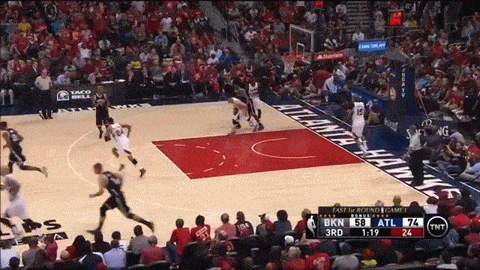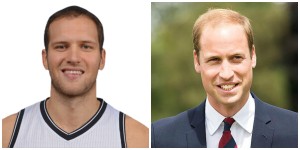Almost immediately after the Brooklyn Nets lost to the Atlanta Hawks, 92-99, in Game 1 of their first-round playoff series, the conversation turned to Brook Lopez’s effectiveness in his limited touches. Lopez tied for the team lead with 17 points on just seven shot attempts (or one more than Earl Clark), causing Hall of Famers Charles Barkley on TNT’s Inside the NBA and Isiah Thomas on NBA TV’s GameTime to get pretty animated in calling out the Nets guards for not feeding the big man more often against Atlanta.
Head coach Lionel Hollins initially dismissed the “gotta get Brook the ball!” criticism after Sunday’s game but acknowledged it the next day and, to their credit, the remaining members of the Nets’ “Big 3” recognized it as well.
From Stefan Bondy, of the New York Daily News:
“We’ll make adjustments, man,” Joe Johnson said. “We’ll get the big fella rolling.”
…
“We just gotta find some actions that work for him,” said Deron Williams. “Because we definitely need to get him the ball, that little pocket pass that we were getting the last half of the season is not there against these guys. They’re doing a good job of taking that away. But like I said, swing, swing and then maybe post him up on the other side. Those are things we can do to get Brook involved, and we need to get him more involved.”
Hollins added: “We just went to other people. That’s why you have a team, that’s why you go out and play with five guys. If we had to depend on Brook to get 20 shots, we were going to lose by 25. So we did what we had to do tonight. On other nights, one player is going to get more shots than other players. You could say we should do something else but it is the way it was.”
In a way, all three are correct. Deron’s explanation is especially on point, though, by giving credit to the defensive activity of the Atlanta Hawks and appropriating blame for the Nets’ limited gameplan. There’s enough of it to go around – and we’ll get to Hollins’s comments and schematic issues in a second – but also plenty of praise for Hawks head coach Mike Budenholzer in identifying and curtailing Brook Lopez’s catch-and-shoot opportunities, particularly off of the pick-and-roll.
As you can see in the above video, every high screen initiated by Lopez or roll to the rim in the first quarter drew an extra Atlanta help defender over to cheat a few steps. It didn’t matter if it was a big (Al Horford or Paul Millsap) conceding the three-pointer to Thaddeus Young from the top of the key or DeMarre Carroll leaving Joe Johnson alone at the arc to help on the roll, it was up to the closest Hawks defender to step in and body Brook on his cuts to the basket, and to prevent him from getting a clean look at his pick-and-roll runner.
The attention didn’t relent in the second half. To be fair, the Nets’ woeful shooting line (5/20 from three) couldn’t quite convince Coach Bud to abandon his defensive strategy and call for the Hawks to start covering shooters, either. Lopez continued to take the contact and collapse the defense on seemingly every cut, while Nets guards eagerly swung the ball on the perimeter to wide-open shooters. It was just the whole shot-making thing that presented an issue for Brooklyn.
In the second half the Hawks began switching up their help coverage a bit more, by sending the weak-side defender to shadow Brook in the lane and sagging off of shooters in the corners. All afternoon the Nets did a decent job of anticipating where the help was coming from on the pick-and-roll (well, except for their 17 turnovers) and even began using some misdirection on Brook’s high screens to get easy baskets with the defense out of position.

Brook Lopez squares up to set the screen towards the sideline as Joe Johnson crosses over to the middle. Jarrett Jack notices that he’s the man to help off of and keeps going towards the basket instead of settling in the left-corner, as his defender (Dennis Schröder) turns to observe Brook’s roll to the hoop and leaves Jack on the back-door cut. The spacing isn’t optimal, with Brook and Jack both basically making the same move, but Jack recognizes his defender’s assignment and beats him for a layup.
As I discussed in the Playoffs Edition of the Three Man Weave, the Atlanta Hawks are not afraid to let their opponents shoot from the perimeter. Combined with Brooklyn’s regular season track record of futility from beyond the arc (26th in the league in team three-point field goal percentage), Atlanta’s “let ‘em have threes” defense shouldn’t be too surprising. Perhaps that’s what Coach Hollins meant with his “if we had to depend on Brook to get 20 shots we’d lose by 25” statement, but at a certain point a team has to rely on their strengths and at least get their best player involved in the offense. As Deron expressed perfectly, once Atlanta took away Brook’s go-to move – the P&R pocket pass-to-runner – there were no secondary actions or post-ups to get the big man touches, outside of self-generated put-backs from his six offensive rebounds.
To hearken back to the Hot Takez for a second, Isiah Thomas wasn’t exactly wrong in admonishing the Brooklyn guards for ignoring Lopez on his many rolls to the rim or (halfhearted) post-up attempts, but the above quote by their head coach puts it into a bit more context. As Bondy wrote, Brook Lopez “became more of a decoy as Atlanta converged on Brooklyn’s pick-and-rolls,” as evidenced by his 42 touches (fifth-most among all Nets in Game 1) and minuscule single-game usage rate (12.2% of possessions). It was apparent early that Hollins’s offensive scheme featured a heavy dose of Iso Joe; which worked to great effect individually, if at the expense of Lopez’s inclusion in the offense.
Regardless of Atlanta’s activity in the lane, forcing the ball to Brook Lopez at least a couple of times on the pick-and-roll would have really opened up room for shooters in Hollins’s perimeter-oriented offense (wait, what?!). The team committed 17 turnovers by skipping the ball around the arc when they could have turned it over just as easily by trying to establish Lopez off the pick or in the post, which might be his best opportunity to touch the ball again in this series (even if he’s trended away from his post-game all season).
The Nets were the league’s third-most effective team at scoring in the paint over the regular season and still generated almost 60% of their points from the paint Sunday, despite completely ignoring Lopez on offense. The Atlanta Hawks worked all afternoon to shade an extra defender towards Lopez to take him out of Brooklyn’s pick-and-roll attack and dared the Nets to beat them from the perimeter. While Lionel Hollins readily accepted the challenge in Game 1’s seven-point defeat, the Brooklyn Nets’ lack of spacing and the national attention on Brook Lopez’s shot output could change the complexion of Wednesday’s offensive gameplan.
